You are using an out of date browser. It may not display this or other websites correctly.
You should upgrade or use an alternative browser.
You should upgrade or use an alternative browser.
Travel Tool Chest / Workbench
- Thread starter Dr.Al
- Start date
Dr.Al
Forum Supporter
- Messages
- 2,651
- Location
- Gloucestershire, UK
This morning, I took the masking tape off...
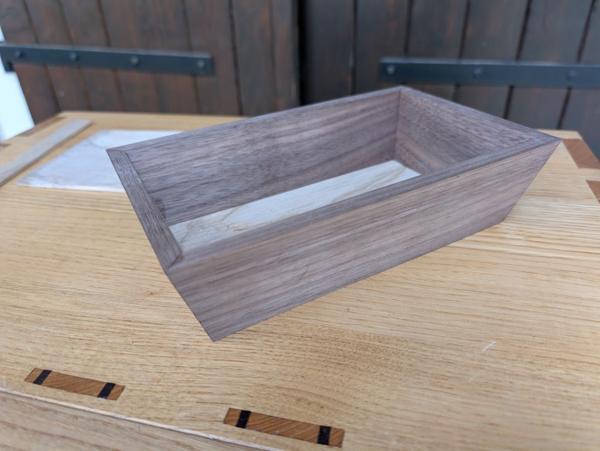
... and then put some more back on! The tape in the next picture is there just to give me an approximate guide for where to saw to when cutting the slots for the reinforcing splines. I used a bit of scrap wood that looked a sensible thickness as a reference, pushing the saw blade down onto the scrap piece and then moving saw and scrap back and forth together to cut the first side of the spline hole:

I then flipped the tray over and did the same again:
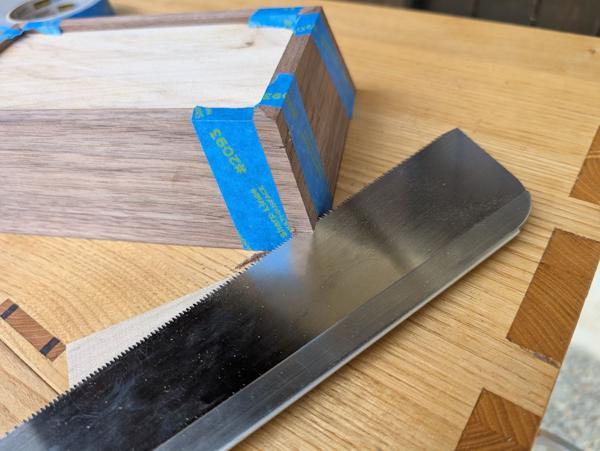
To take account of the saw kerf, I took a few plane shavings off the scrap wood. I then used the spline-to-be (an off-cut of the Sycamore I used as the base) as an additional spacer...
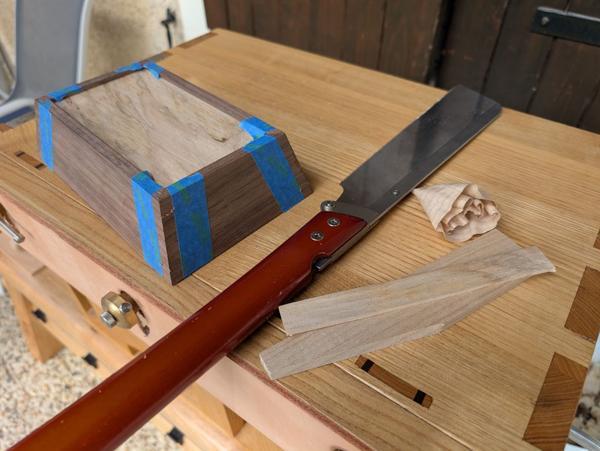
... allowing me to saw the other side of the spline hole:
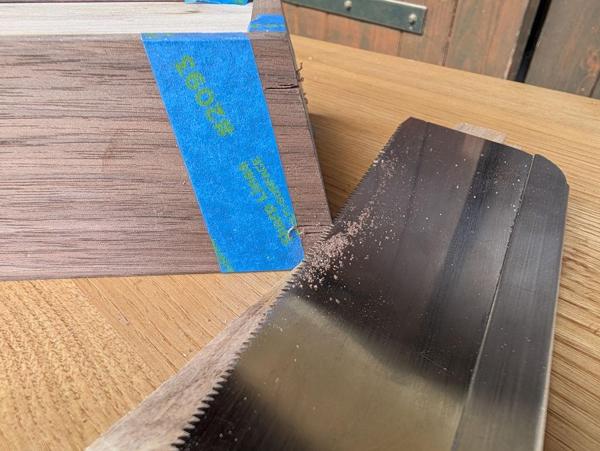
To clean out the spline socket, I clamped the tray to the back of the tool chest (it's much too big for the maximum depth of the vice):
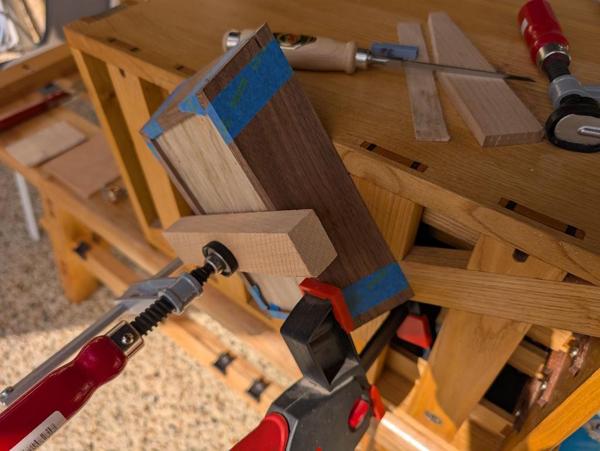
The waste could then be chiselled out with a 2 mm chisel:
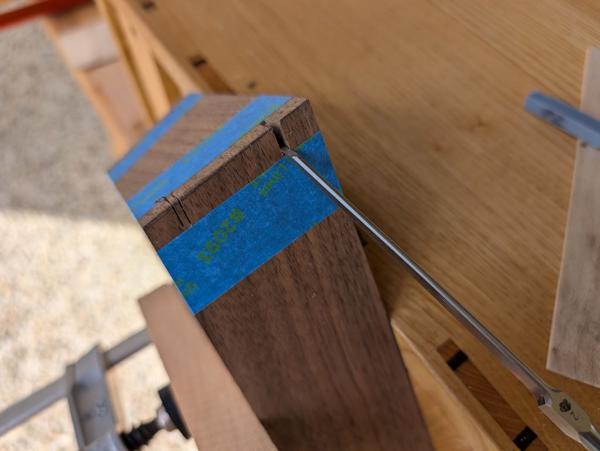
Seven of the pockets went well. One ended up quite a bit bigger: I think I must have put the rib at the back of the saw on the spacer piece, resulting in it tilting down when sawing.
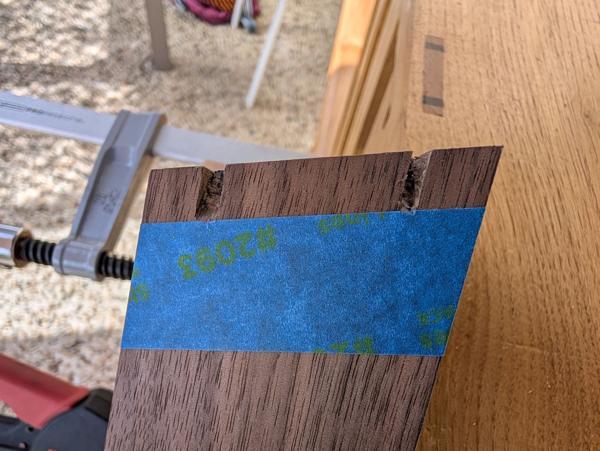
To deal with that, I just made all of the spline sockets at the bottom the same size as that one, resulting in four thick spline sockets at the bottom and four thinner ones at the top. Of course, that meant that I also needed some thicker splines.
Having retreated indoors due to the heat and humidity, I clamped the spacer piece in the vice and used the Dozuki to resaw it thinner:

The cut-off bit that had been resawn then got planed down to thickness, before chopping it up into bits:
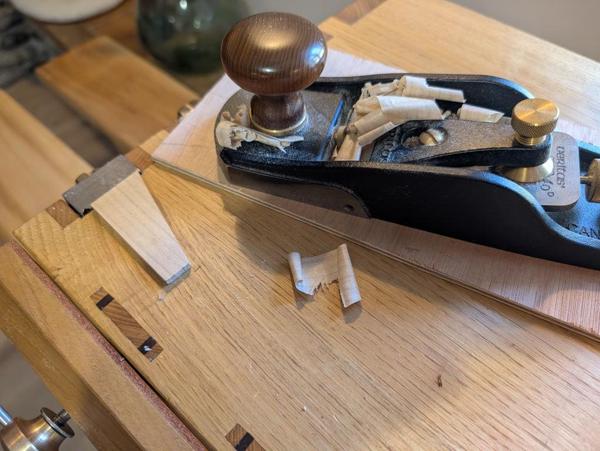
After going round each pocket and making the ends of the spline sockets vertical (rather than parallel with the mitred corners: that means the splines can have square edges which is much easier) and generally tweaking everything until it looked good, glue was applied to the inside of the spline sockets and the faces of the splines and then they were shoved into place:
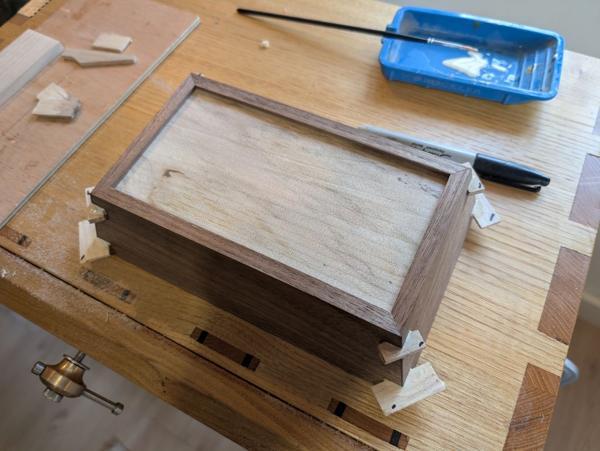
The little pen marks you can see in that image are to show which is the rough-sawn edge (one edge is planed smooth to help produce a clean fit against the corners of the socket).
Tomorrow (my last full day here) I'll hopefully get those splines cut off and planed smooth and then, all being well, the tray will be complete.

... and then put some more back on! The tape in the next picture is there just to give me an approximate guide for where to saw to when cutting the slots for the reinforcing splines. I used a bit of scrap wood that looked a sensible thickness as a reference, pushing the saw blade down onto the scrap piece and then moving saw and scrap back and forth together to cut the first side of the spline hole:

I then flipped the tray over and did the same again:

To take account of the saw kerf, I took a few plane shavings off the scrap wood. I then used the spline-to-be (an off-cut of the Sycamore I used as the base) as an additional spacer...

... allowing me to saw the other side of the spline hole:

To clean out the spline socket, I clamped the tray to the back of the tool chest (it's much too big for the maximum depth of the vice):

The waste could then be chiselled out with a 2 mm chisel:

Seven of the pockets went well. One ended up quite a bit bigger: I think I must have put the rib at the back of the saw on the spacer piece, resulting in it tilting down when sawing.

To deal with that, I just made all of the spline sockets at the bottom the same size as that one, resulting in four thick spline sockets at the bottom and four thinner ones at the top. Of course, that meant that I also needed some thicker splines.
Having retreated indoors due to the heat and humidity, I clamped the spacer piece in the vice and used the Dozuki to resaw it thinner:

The cut-off bit that had been resawn then got planed down to thickness, before chopping it up into bits:

After going round each pocket and making the ends of the spline sockets vertical (rather than parallel with the mitred corners: that means the splines can have square edges which is much easier) and generally tweaking everything until it looked good, glue was applied to the inside of the spline sockets and the faces of the splines and then they were shoved into place:

The little pen marks you can see in that image are to show which is the rough-sawn edge (one edge is planed smooth to help produce a clean fit against the corners of the socket).
Tomorrow (my last full day here) I'll hopefully get those splines cut off and planed smooth and then, all being well, the tray will be complete.
Dr.Al
Forum Supporter
- Messages
- 2,651
- Location
- Gloucestershire, UK
This morning, I started by sawing off the bulk of the waste with the Dozuki. This was done with one hand holding the tray down on top of the chest: it didn't feel like it needed clamping at all.

That left a rough finish and a millimetre or two of waste to get rid of.
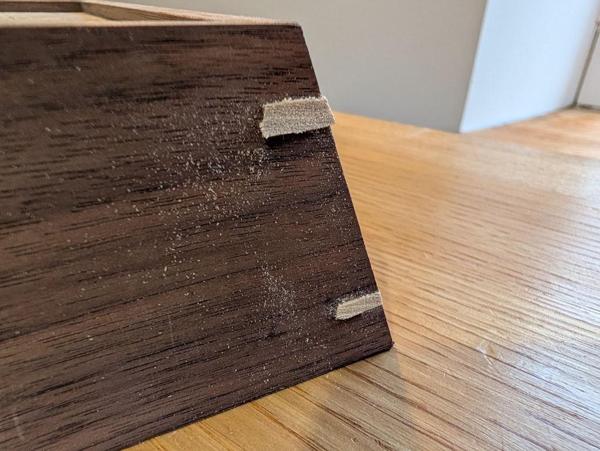
That got pared flush with a chisel...
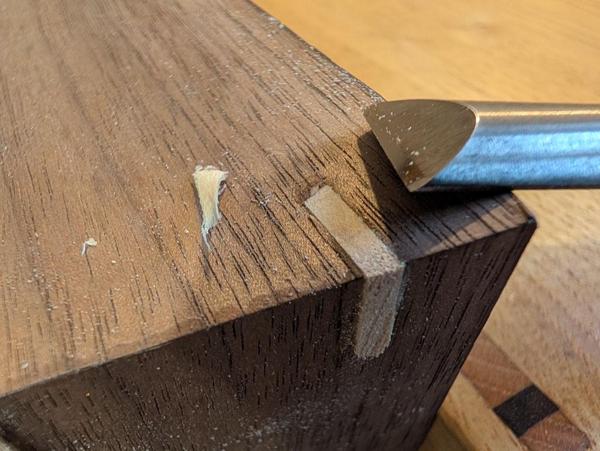
... and then I took a light pass with a smoothing plane:
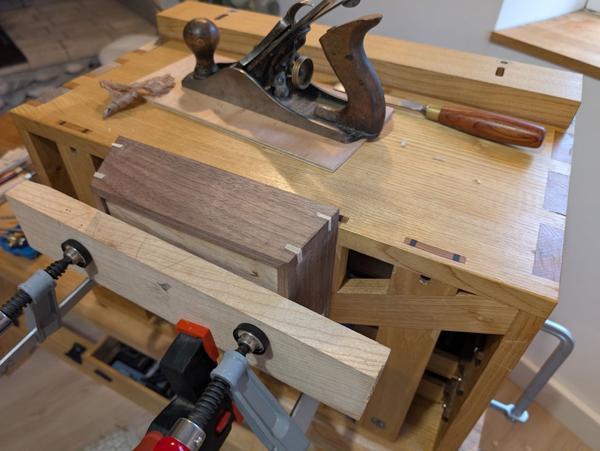
That's it for now. I expect I'll end up doing a bit more smoothing planing when I get home: it's bound to get the odd little knock in transit. Once I'm home, I'll do any final tidying that I think is necessary and then apply some oil.
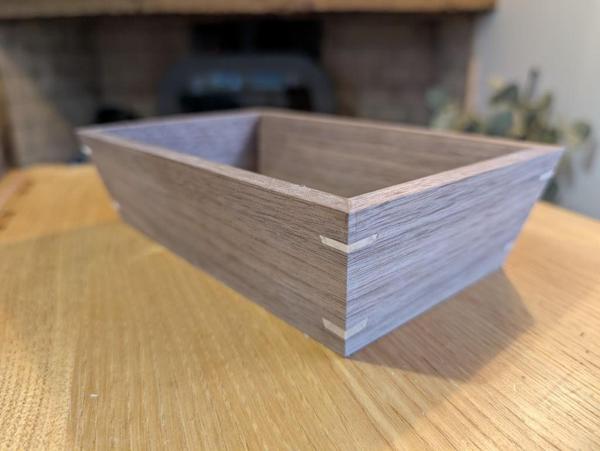

That left a rough finish and a millimetre or two of waste to get rid of.

That got pared flush with a chisel...

... and then I took a light pass with a smoothing plane:

That's it for now. I expect I'll end up doing a bit more smoothing planing when I get home: it's bound to get the odd little knock in transit. Once I'm home, I'll do any final tidying that I think is necessary and then apply some oil.

arther dailey
Member
- Messages
- 6,926
- Location
- England
apart from the obvious skill involved it is loverly to see the wood after a truly sharp chisel has been used , pleasure to see.Over the last couple of days we've been out and about in the Pyrenees. The scenery round here is beautiful and we even got to see a golden eagle up extremely close when it flew across in front of us. With all that, I didn't do any more on the box until this morning.
Before doing anything on the box itself, I decided to fix the drawer supports in place permanently:
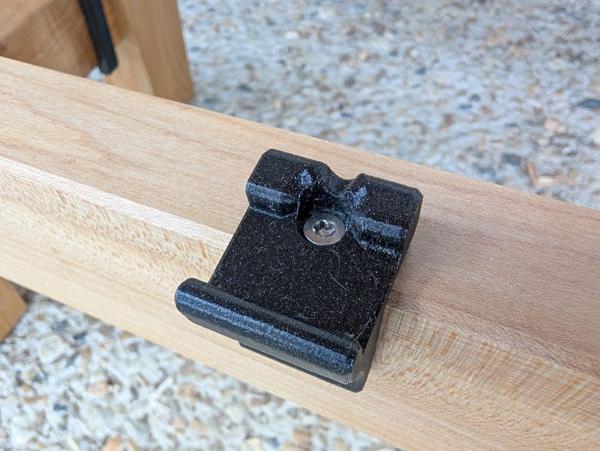
I really like having the three most useful drawers lying on the bench stretchers so I'm happy to commit to the screw holes now (the supports were originally just held in place with double-sided tape).
Returning to the box, the first thing I did today was chisel the mitred corners using the mitre guide I prepared in the last instalment:

I then relieved all the inside corners of the tails in order to help the joints go together easily:

For the back of the chest, I didn't have any Sycamore that was big enough, so I pulled out a bit of 6 mm ish rough sawn Sweet Chestnut:
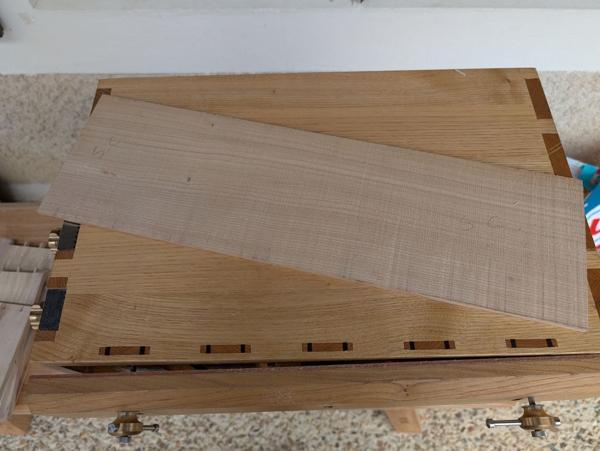
After cutting it in half, I planed that on both sides, resulting in a piece about 5 mm thick:

I could then plough some matching grooves and it was nice to be able to use the little plough plane that I found a spot for in one of the drawers. It took a while to get everything set-up: various stops clamped to the bench and the assembly of the plough plane itself, which is packed in pieces in the tool chest. However, once everything was set up, ploughing the four grooves was completed very quickly:
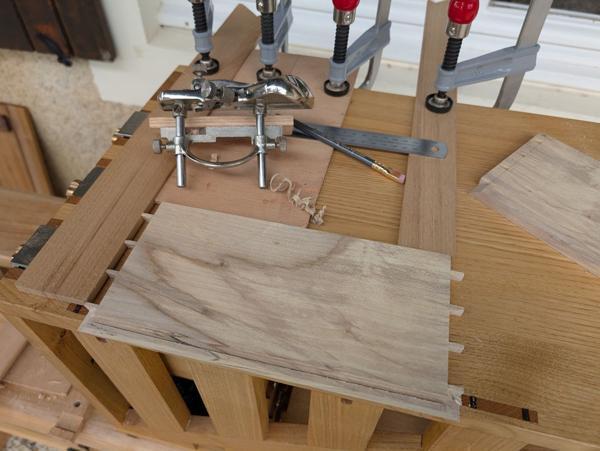
The four side pieces with their grooves:

I'm planning to make this into a box with two drawers. I've brought a piece of 16 mm-ish thick American Black Walnut with me to act as the drawer fronts. Unlike the previous drawer box (which had the dividing "shelf" hidden behind a lip on the lower drawer), I've decided to make the "shelf" visible but to try to grain match it to the drawer fronts. To that end, I marked up a thin-ish strip in the middle of the plank:
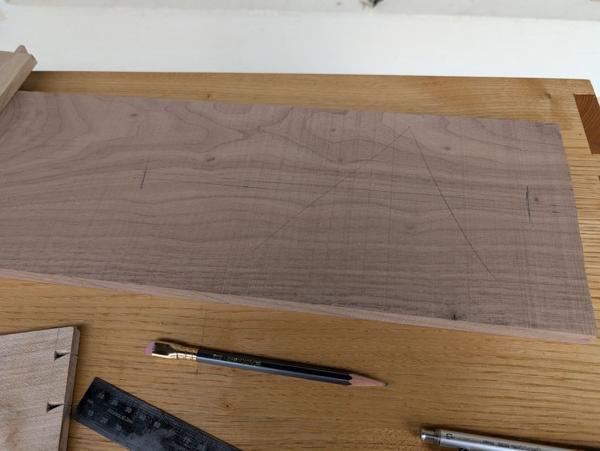
After cross-cutting to length, I reinforced the pencil marks...
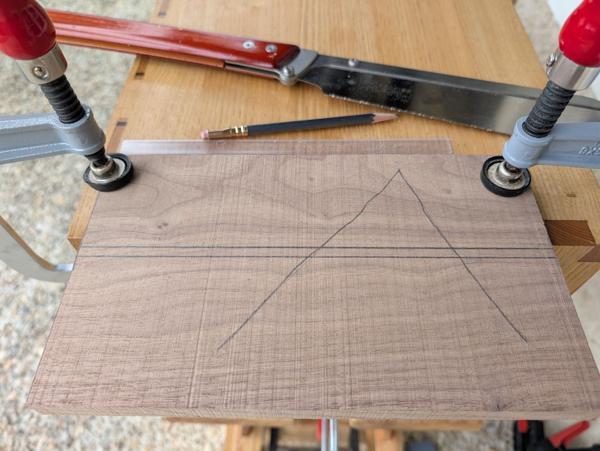
... and (after taking a deep breath as I was a bit nervous about sawing skew-whiff), I ripped the board into three pieces with the Dozuki:
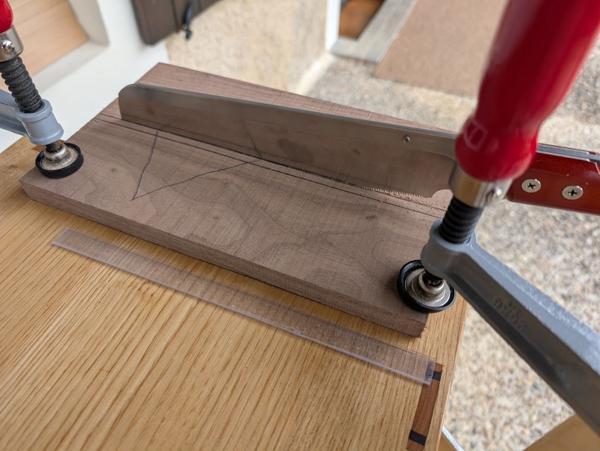
I was rather pleased with how that went:
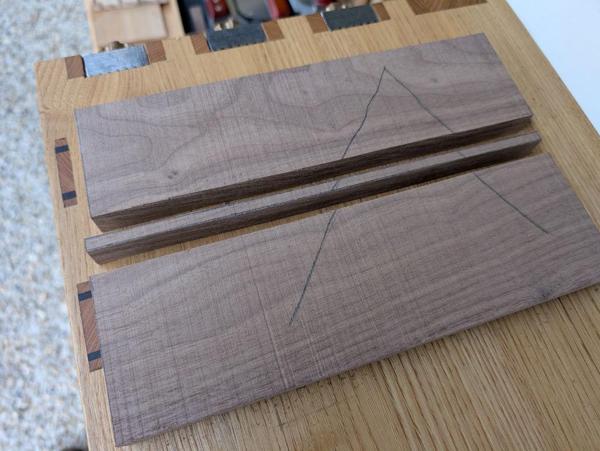
The other half of the Sweet Chestnut plank will be used for most of the shelf, but the thinner bit of Walnut will act as a trim to (hopefully) make it look better. Without bothering to try to plane the face sides down at all, I just planed the joining edge straight and square on the two pieces:
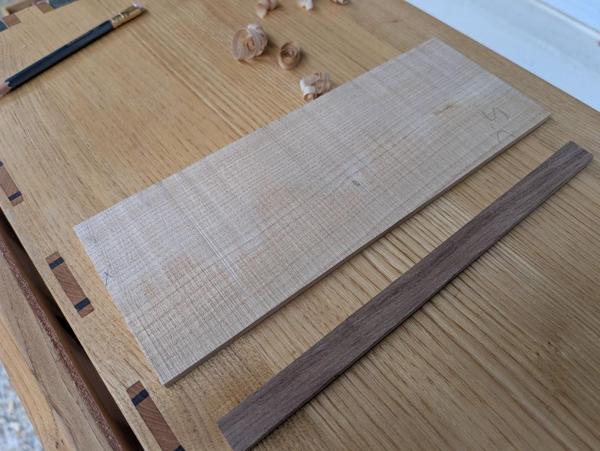
Glue was applied...
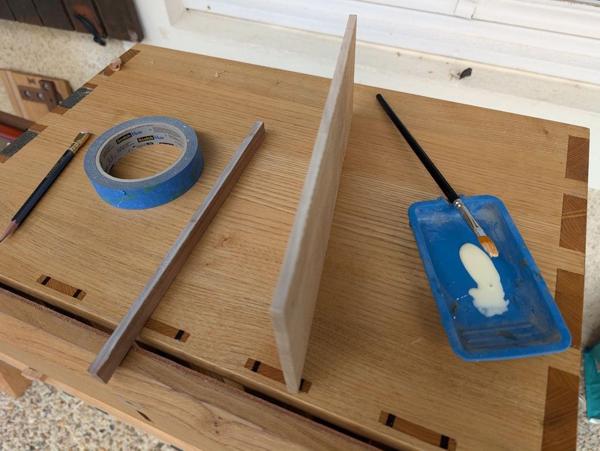
... and then I got a bit carried away with masking tape:
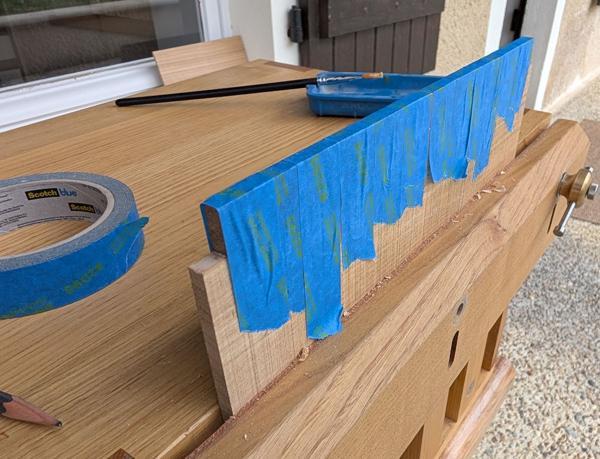
Once the glue has dried, I'll plane the faces and then trim it to the final size. I'm not going to cut the housing in the case sides until I've planed the shelf to thickness; that way I can be more confident of getting a snug housing joint.
At this point, I realised that I won't be able to finish this drawer box while I'm in France. I hadn't planned what I was going to make very carefully for this trip, just chucking a load of wood in a bag and assuming I'd figure it out when I got here. I did, however, put a load of thin off-cuts of Sycamore in, thinking they would be good for drawer sides. They will be good for drawer sides, but I've made this box quite big as I wanted relatively deep drawers and as such the Sycamore pieces are too narrow to be used for the sides of the two drawers:
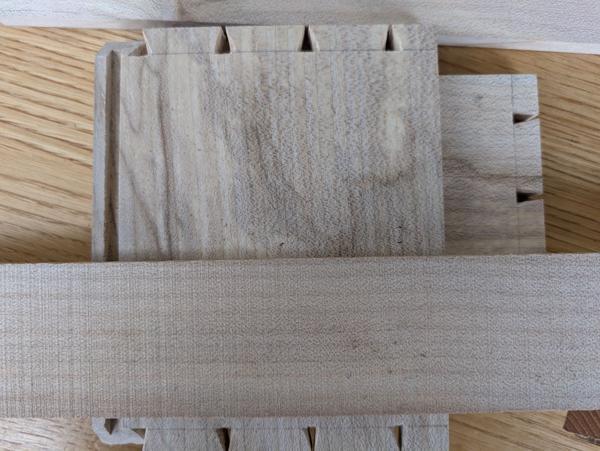
I could make the top drawer narrower than the bottom one and continue to make the top drawer with that Sycamore (and sort out the bottom drawer when I get back home) or I could make them both equal and sort both drawers out when I get home. Either way, the box won't be finished while I'm here, but that doesn't really matter - it's still nice to have some woodworking tasks to get on with. I'll have a rummage through the rest of the wood that I brought with me and I may be able to use that Sycamore for something else instead, or alternatively just make (or start making) a completely different box altogether. This is the downside of not planning the boxes I'm going to make in advance!
Dr.Al
Forum Supporter
- Messages
- 2,651
- Location
- Gloucestershire, UK
I'm back home again now. I haven't had a lot of time free to finish off the two boxes, but I have applied two coats of Mike's Magic Mix to the mitred tray:
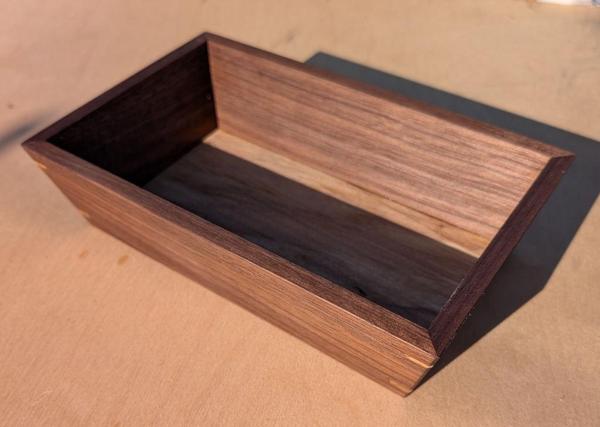
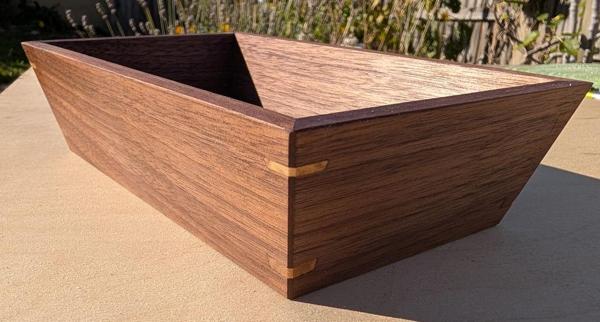

I think this tray is going to become a home for the (three) remote controls in the lounge, which currently live in a rather shabby wicker basket.



I think this tray is going to become a home for the (three) remote controls in the lounge, which currently live in a rather shabby wicker basket.
Dr.Al
Forum Supporter
- Messages
- 2,651
- Location
- Gloucestershire, UK
Since getting back, I haven't managed to spend much time on the drawer box, but I did have a rummage around to try to find some material for the drawer sides. The only stuff that looked promising was in the form of a (somewhat excessively) large plank of sweet chestnut:

That's obviously far too much wood for the sides and back of two drawers, so I started by getting the big Ryoba out and chopping the end off:
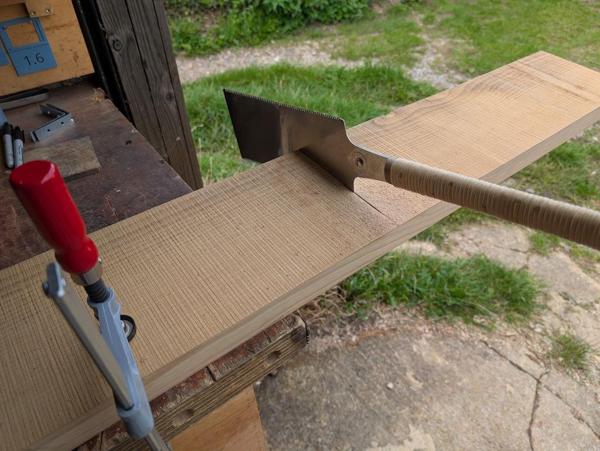
I then started ripping it to (a bit over-) width using the big Ryoba but it was feeling hard work so I swapped to the little one and that went much quicker:

The big Ryoba was the one that I used to use for resawing before I bought my bandsaw, so those rip teeth have had a fairly hard life; I suspect they're not as sharp as they once were.
With the piece cut a bit smaller, I could plane both faces...
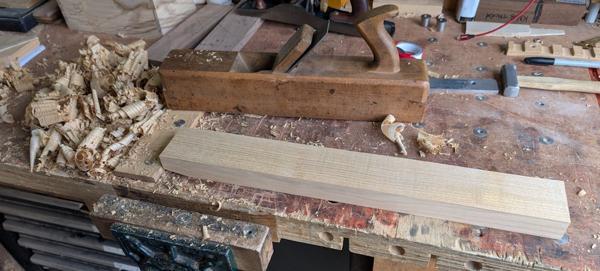
... and then plane both edges, making sure one edge was square to one face and the other square to the other:

I could then use the face/edge pairs as references against the bandsaw fence and table and chop the plank into three bits, two with one planed face and one with none:
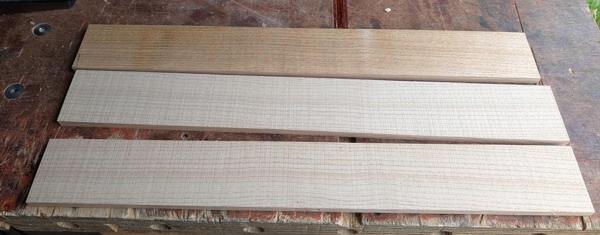
Those pieces should give me plenty of stock for the sides and back of the drawers. The next job will be to plane them all round, but I expect that'll be next weekend, which at least has the advantage of allowing them a bit of post-resaw time to bend/twist or whatever else they want to do before I plane them.

That's obviously far too much wood for the sides and back of two drawers, so I started by getting the big Ryoba out and chopping the end off:

I then started ripping it to (a bit over-) width using the big Ryoba but it was feeling hard work so I swapped to the little one and that went much quicker:

The big Ryoba was the one that I used to use for resawing before I bought my bandsaw, so those rip teeth have had a fairly hard life; I suspect they're not as sharp as they once were.
With the piece cut a bit smaller, I could plane both faces...

... and then plane both edges, making sure one edge was square to one face and the other square to the other:

I could then use the face/edge pairs as references against the bandsaw fence and table and chop the plank into three bits, two with one planed face and one with none:

Those pieces should give me plenty of stock for the sides and back of the drawers. The next job will be to plane them all round, but I expect that'll be next weekend, which at least has the advantage of allowing them a bit of post-resaw time to bend/twist or whatever else they want to do before I plane them.
Dr.Al
Forum Supporter
- Messages
- 2,651
- Location
- Gloucestershire, UK
I love the fact you basically do 99% of your woodwork by hand. Personally I'm all for making my life easier with power tools but the respect I have for those who almost exclusively work by hand is huge!
I used to do it mostly with power tools but got fed up with the noise and dust and hence the fact I spent so much of the garage time wearing a face mask, ear defenders and dust mask. For me it's more about the process than the end result anyway, so if it takes a bit longer but the process is enjoyable then that's a good thing, especially if I'm also learning new skills rather than just relying on machinery. I still see the act of selling my table saw as one of the best things I ever did.
Dr.Al
Forum Supporter
- Messages
- 2,651
- Location
- Gloucestershire, UK
I want one now, but it would never be as good as yours
Where do you get your timber?
Mostly from Wentwood Timber Centre near Chepstow. They only stock native timbers (and mostly stuff from within not many miles of Chepstow) but they seem to be consistently substantially cheaper than anywhere else I've been. The timber yard / showroom is in a lovely location too! Non-native stuff (e.g. American Black Walnut) has generally come from Yandles in Somerset, although there are a few others I've been too when in the area (e.g. Tyler Hardwoods near Hungerford/Marlborough and Surrey Timbers in Guildford). None anywhere near Wirral I'm afraid.





